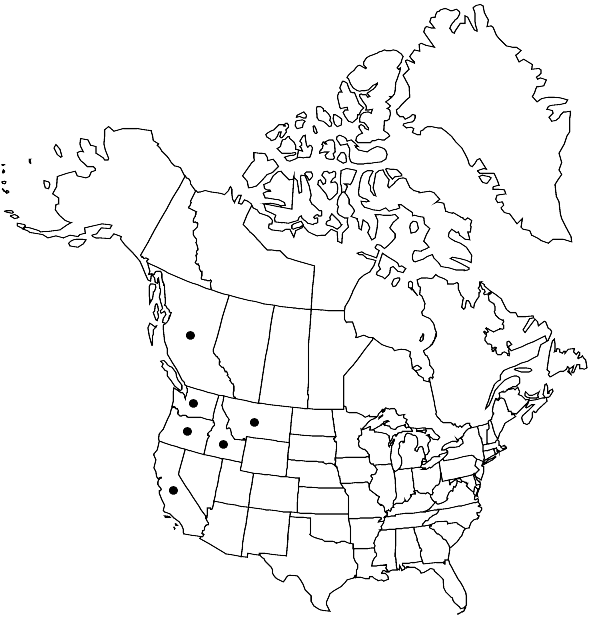Grimmia leibergii
Actes Soc. Linn. Bordeaux, sér. 5, 9: 528. 1895,.
Plants robust, ascending from a decumbent base, dark olivaceous. Stems 5–12 cm, repeatedly dichotomous, central strand absent. Leaves loosely appressed when dry, patent to spreading when moist, often becoming secund distally on the stem, lanceolate to ovatelanceolate, 3–4 × 0.6–0.9 mm, keeled, margins recurved on both sides, awns denticulate, flattened proximally, sometimes decurrent, costa yellowish to pale orange proximally, wider (± 100 µm) near the base, channeled distally, semicircular on abaxial side; basal juxtacostal laminal cells elongate to linear, weakly orange at insertion, nodulose, thick-walled; basal marginal laminal cells in a few rows quadrate to short-rectangular, thick-walled; medial laminal cells quadrate to short-rectangular, strongly sinuose, thin to thick oblique transverse walls and extremely thick lateral walls; distal laminal cells 1-stratose, margins partly 2-stratose. Gemmae absent. Sexual condition dioicous. Seta arcuate, 3–4 mm. Capsule occasionally present, exserted, yellowish green, oblong-ovoid, striate, exothecial cells rather thick-walled, annulus present, operculum rostrate, peristome teeth orange to reddish, perforated, irregularly cleft at apex, nearly smooth basally, papillose distally. Calyptra mitrate.
Habitat: Dry acidic boulders
Elevation: moderate elevations (400-500 m)
Distribution

B.C., Calif., Idaho, Mont., Oreg., Wash., Eurasia
Discussion
Grimmia leibergii, formerly thought to be endemic to western North America, has the habit of Racomitrium heterostichum. Nearly all specimens of G. leibergii in NY, and probably also in other North American herbaria, have been filed as varieties of R. heterostichum (= Bucklandiella heterosticha). This confusion probably accounts for G. leibergii not being commonly recognized in North America. J. B. Leiberg (1893) stated that it is most closely related to G. decipiens, a species that does not occur in North America. Both taxa share broadly ovate-lanceolate leaves with both margins recurved, rectangular mid leaf cells with extremely thick and sinuose lateral walls and elongate to linear, nodulose, thick-walled basal juxtacostal cells. However, G. decipiens is autoicous, it is a much smaller species, with long, sharply denticulate awns. The gametophytes form comal tufts, so the distal leaves are 2–3 times longer than the lower leaves, and are not secund. Grimmia jacutica has been described separately from eastern Asia and Alaska but all specimens of it that we have examined are just slightly smaller forms of G. leibergii with slightly more sinouse mid leaf cells. The extension of G. leibergii into eastern Asia is a significant find and speaks to our poor knowledge of Grimmia distribution patterns on a worldwide basis.
Selected References
None.
Lower Taxa
"thick" is not a number.
